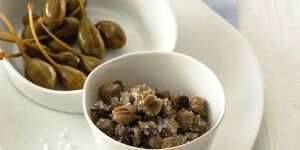Cappero di Pantelleria (Pantelleria caper)

IGP Cappero di Pantelleria is an Italian caper - the geographic term "Pantelleria" refers to a volcanic island south of Sicily.
DESCRIPTION: shape: globular; colour: mustard-green; odour: strong aromatic, with no extraneous influence.
GEOGRAPHICAL AREA: The entire island of Pantelleria.
EVIDENCE: The first historically verified evidence specifically regarding Pantelleria capers comes from the essay by Prof. P. Calcara, Breve cenno sulla Geognosia ed Agricultura dell'isola di Pantelleria ("A Short Account of the Geognosy and Agriculture of the Island of Pantelleria"), published in Palermo in 1855 in the Giornale della Commissione d'Agricoltura e Pastorizia in Sicilia. This essay points out the economic-commercial value of the caper for the society of Pantelleria at that time: "The caper grows spontaneously along the southern coast and on the arid cliffs of the island, and the poor gather the buds in the months of July and August, before they flower, and sell them to a class of people who, after separating them according to size, press them in brine or vinegar and then put them on the market". The economic value of the caper for Pantelleria is also confirmed by other reliable historical sources such as: the 1894 edition of the German Brockhaus encyclopedia, under the entry "Pantelleria", and Dr. Pietro Brignone Boccanera in his Cenni Storici su Pantelleria ("A Historical Account of Pantelleria"), published in Partanna in 1908, which states that, beginning in the second half of the 19th century, ".... the caper was cultivated and the island reached a production of 60,000 kg. of capers". This is sufficient to point out the increasing importance of the caper in the island's economy, even if secondary to the importance of grape growing, and especially the "zibibbo" grape.
More recently, beginning in the 1960s, caper growing surpassed grape growing in importance, and caper growing has continued to increase its area under cultivation and production, reaching around 1,200 tonnes in 1983. At the present time there is the Cooperativa agricola tra produttori capperi (Caper Producers' Agricultural Cooperative), founded in 1971, which is the advocate for the promoting of the Pantelleria caper. The proposal for the Pantelleria caper production regulations was published in the G.Ü. of 3 October 1993, and the D.M. recognition of the "Cappero di Pantelleria" ("Pantelleria caper") P.G.I, of 2 December 1993 was published in the G.U. of 27 December 1993.
METHOD OF PRODUCTION: The caper fields for the production of "Pantelleria capers" must consist of plants of the botanical species Capperis spinosa variety inermis cultivar nocellara. A maximum of 10% of other:varieties is permitted. The caper fields for the production of the P.G.I. "Cappero di Pantelleria" ("Pantelleria caper") must use the cultivation methods traditional to the area and must be able to provide the flower buds (capers) with the specific characteristics. The maximum production of fresh capers entitled to the IGP. "Cappero di Pantelleria" is established at 1.5 kg. per plant and 2,250 kg. per hectare. Salting is done with the initial use of sea salt in the amount of 40% of the total mass of capers, which is remixed daily to aid lactic fermentation. Subsequent operations are the addition of sea salt in the amount of 25% of the mass, remixing and the daily draining of the liquid portion resulting from the natural depositing of the moisture in the capers. The capers acquire the characteristics necessary for consumption upon reaching the appropriate maturation, after approximately ten days.
LINK: The island of Pantelleria is of volcanic origin and is extremely arid, due to very little rainfall, and therefore is an ideal environment for the growing of capers. Over the centuries the Pantelleria caper has become very famous for its aromatic characteristics. Thus arises the necessity to protect this product from other similar products, which come from the Mediterranean basin but which do not have its particular qualities. The area of production includes the entire island of Pantelleria, in the Province of Trapani. The extent of the area involved, the special care in cultivation and the creation of efficient processing and marketing structures have made the caper plant a special crop of great economic importance on the island.
Reference: The European Commission